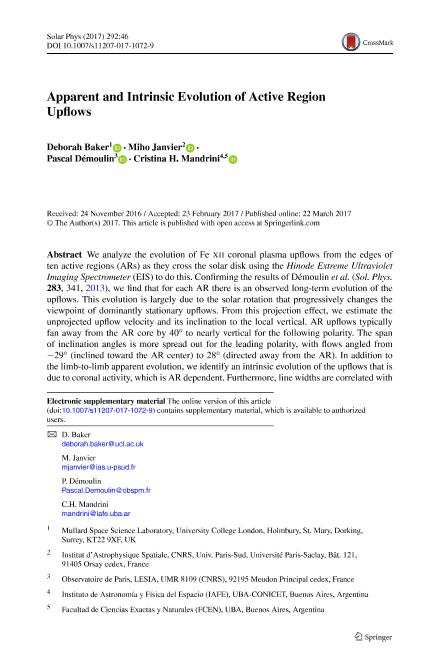Mostrar el registro sencillo del ítem
dc.contributor.author
Baker, Deborah
dc.contributor.author
Janvier, Miho
dc.contributor.author
Démoulin, Pascal

dc.contributor.author
Mandrini, Cristina Hemilse

dc.date.available
2017-11-01T17:22:58Z
dc.date.issued
2017-04
dc.identifier.citation
Baker, Deborah; Janvier, Miho; Démoulin, Pascal; Mandrini, Cristina Hemilse; Apparent and Intrinsic Evolution of Active Region Upflows; Springer; Solar Physics; 292; 46; 4-2017; 1-21
dc.identifier.issn
0038-0938
dc.identifier.uri
http://hdl.handle.net/11336/27326
dc.description.abstract
We analyze the evolution of Fe xii coronal plasma upflows from the edges of ten active regions (ARs) as they cross the solar disk using the Hinode Extreme Ultraviolet Imaging Spectrometer (EIS) to do this. Confirming the results of Démoulin et al. (Sol. Phys.283, 341, 2013), we find that for each AR there is an observed long-term evolution of the upflows. This evolution is largely due to the solar rotation that progressively changes the viewpoint of dominantly stationary upflows. From this projection effect, we estimate the unprojected upflow velocity and its inclination to the local vertical. AR upflows typically fan away from the AR core by 40° to nearly vertical for the following polarity. The span of inclination angles is more spread out for the leading polarity, with flows angled from −29° (inclined toward the AR center) to 28° (directed away from the AR). In addition to the limb-to-limb apparent evolution, we identify an intrinsic evolution of the upflows that is due to coronal activity, which is AR dependent. Furthermore, line widths are correlated with Doppler velocities only for the few ARs with the highest velocities. We conclude that for the line widths to be affected by the solar rotation, the spatial gradient of the upflow velocities must be large enough such that the line broadening exceeds the thermal line width of Fe xii. Finally, we find that upflows occurring in pairs or multiple pairs are a common feature of ARs observed by Hinode/EIS, with up to four pairs present in AR 11575. This is important for constraining the upflow-driving mechanism as it implies that the mechanism is not local and does not occur over a single polarity. AR upflows originating from reconnection along quasi-separatrix layers between overpressure AR loops and neighboring underpressure loops is consistent with upflows occurring in pairs, unlike other proposed mechanisms that act locally in one polarity.
dc.format
application/pdf
dc.language.iso
eng
dc.publisher
Springer

dc.rights
info:eu-repo/semantics/openAccess
dc.rights.uri
https://creativecommons.org/licenses/by-nc-sa/2.5/ar/
dc.subject
Active Regions, Magnetic Fields
dc.subject
Active Regions, Velocity Field
dc.subject.classification
Astronomía

dc.subject.classification
Ciencias Físicas

dc.subject.classification
CIENCIAS NATURALES Y EXACTAS

dc.title
Apparent and Intrinsic Evolution of Active Region Upflows
dc.type
info:eu-repo/semantics/article
dc.type
info:ar-repo/semantics/artículo
dc.type
info:eu-repo/semantics/publishedVersion
dc.date.updated
2017-10-31T20:06:49Z
dc.journal.volume
292
dc.journal.number
46
dc.journal.pagination
1-21
dc.journal.pais
Alemania

dc.journal.ciudad
Berlin
dc.description.fil
Fil: Baker, Deborah. Colegio Universitario de Londres; Reino Unido
dc.description.fil
Fil: Janvier, Miho. Universite Paris Sud; Francia
dc.description.fil
Fil: Démoulin, Pascal. Centre National de la Recherche Scientifique. Observatoire de Paris; Francia
dc.description.fil
Fil: Mandrini, Cristina Hemilse. Consejo Nacional de Investigaciónes Científicas y Técnicas. Oficina de Coordinación Administrativa Ciudad Universitaria. Instituto de Astronomía y Física del Espacio. - Universidad de Buenos Aires. Facultad de Ciencias Exactas y Naturales. Instituto de Astronomía y Física del Espacio; Argentina
dc.journal.title
Solar Physics

dc.relation.alternativeid
info:eu-repo/semantics/altIdentifier/doi/http://dx.doi.org/10.1007/s11207-017-1072-9
dc.relation.alternativeid
info:eu-repo/semantics/altIdentifier/url/https://link.springer.com/article/10.1007%2Fs11207-017-1072-9
dc.relation.alternativeid
info:eu-repo/semantics/altIdentifier/url/https://arxiv.org/abs/1702.06022
Archivos asociados
